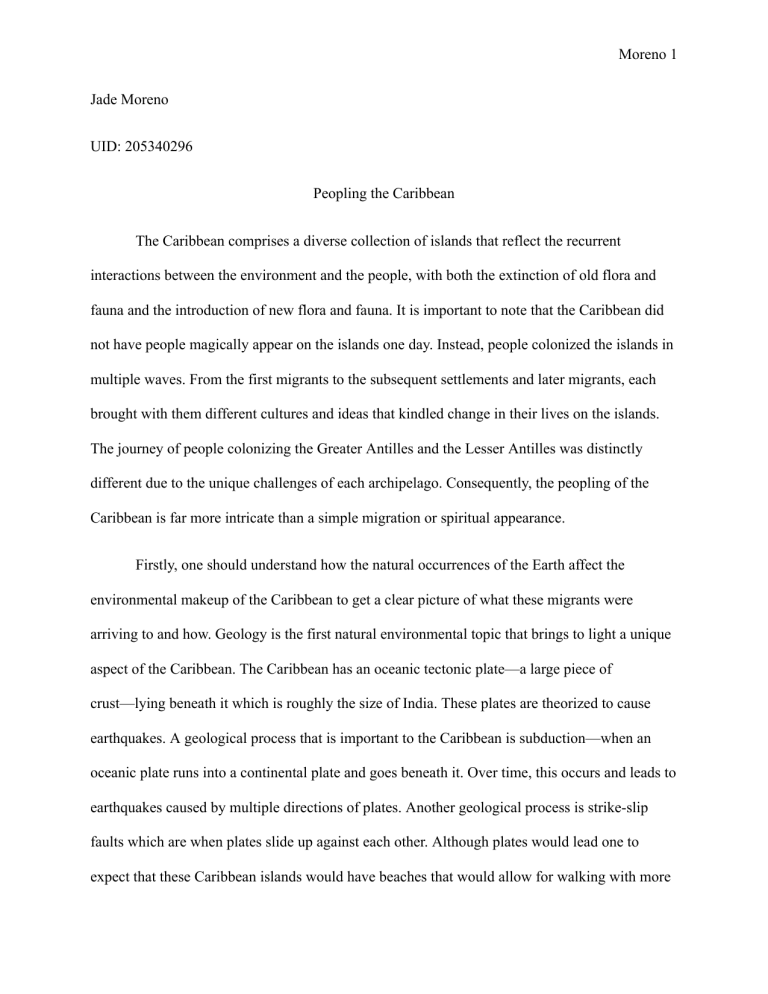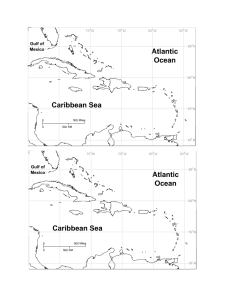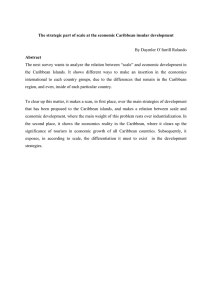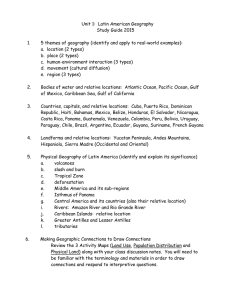
Moreno 1 Jade Moreno UID: 205340296 Peopling the Caribbean The Caribbean comprises a diverse collection of islands that reflect the recurrent interactions between the environment and the people, with both the extinction of old flora and fauna and the introduction of new flora and fauna. It is important to note that the Caribbean did not have people magically appear on the islands one day. Instead, people colonized the islands in multiple waves. From the first migrants to the subsequent settlements and later migrants, each brought with them different cultures and ideas that kindled change in their lives on the islands. The journey of people colonizing the Greater Antilles and the Lesser Antilles was distinctly different due to the unique challenges of each archipelago. Consequently, the peopling of the Caribbean is far more intricate than a simple migration or spiritual appearance. Firstly, one should understand how the natural occurrences of the Earth affect the environmental makeup of the Caribbean to get a clear picture of what these migrants were arriving to and how. Geology is the first natural environmental topic that brings to light a unique aspect of the Caribbean. The Caribbean has an oceanic tectonic plate—a large piece of crust—lying beneath it which is roughly the size of India. These plates are theorized to cause earthquakes. A geological process that is important to the Caribbean is subduction—when an oceanic plate runs into a continental plate and goes beneath it. Over time, this occurs and leads to earthquakes caused by multiple directions of plates. Another geological process is strike-slip faults which are when plates slide up against each other. Although plates would lead one to expect that these Caribbean islands would have beaches that would allow for walking with more Moreno 2 reefs due to these plateaus—flat, elevated land mass with a higher rise on one side—created by these tectonic plates and geological processes. However, this is not the case. Some of the islands are formed from volcanic materials and volcanoes like Dominica. Other islands are made of other compositions that reflect the geological processes that have occurred to make them. Therefore, these islands tend to not see massive reefs. Another environmental topic that should be explored to understand the Caribbean are ocean currents which are driven by wind, water density, and tides. These all would have contributed to the routes that the canoes of the migrants traveled upon to arrive on these islands. The natural world is just as important to understand how the people came to occupy and move around these islands (Dunnavant 2023). Before human colonization, the Caribbean environment was vastly different in comparison to the one Europeans arrived at in 1492 and today. Like most islands, the isolation leads to less diverse flora and fauna due to the animals' challenges in getting to the island. Consequently, the species on islands adapt and form unique niches. On these Caribbean islands, the lack of large predators and abundant resources was inviting to the first arriving humans. The lack of large predators meant that the species on the islands were unfamiliar with threats, making them vulnerable to hunting. Large species like the gigantic sloth went extinct because they were valuable and easily captured food sources. Additionally, the vast, diverse water environments were filled with many species to provide richer resources for humans. As mentioned, the colonization of the Caribbean led to many changes, but the islands were also changed by other factors. One such factor is climate change. With the end of the Pleistocene, sea levels rose substantially, which led to flooding and the disappearance of land masses. It is a possibility that this occurrence led the first humans to make the migration to the Caribbean islands for new space and resources (Wilson 2007, 25-26). Moreno 3 However, the true question is their origin, since there are plausible explanations for their venture from the mainland. Determining the first humans’ point of origin is a challenge because, like most migrations, there is nonlinear movement from one island to another. Many archaeological sites on the mainland and Caribbean islands have been examined to answer this question through the analysis of stone artifacts. The region that is most supported as the point of origin for the first migrants is Central America. Researchers like William Coe and Koslowski have comparatively researched sites in the Caribbean and the mainland. Each of them found similarities in tools between the Central American sites and the Caribbean site that they were excavating. The weak chronology of the Caribbean at the time meant these were tenuous findings because sites like Sand Hill in Belize led to the illumination of chronology as a problem for Caribbean archaeology (Wilson 2007, 32). With the new decade, the archaeological site of Colha in Belize presented an opportunity for researchers to refine the chronology of the Caribbean, which had posed challenges as mentioned. At Sand Hill and sites in the Greater Antilles, similar blades were found, which indicated that the Yucatan was the most likely place of origin. Despite the strong evidence found at Sand Hill, there is not a robust set of lithic tool evidence from this period. The lack of occupation of the Lesser Antilles at the time further implies that a Western migration is most probable. Further research on winds and currents by Richard Callaghan leads to conclusions about the first migrants’ point of origin because these both affect how humans traveled to the islands, with the Greater Antilles being more easily reached from South America. Overall, the research into the migrants’ point of origin indicates a consensus that they were from South America (Wilson 2007, 33). Moreno 4 As archaeologists examined sites in the early 1900s, there was speculation as to whether these were early or late sites due to the unreliable chronology of the Caribbean. Researchers like Jacques Roumain argued that the lithics were tied to a certain group when the Spaniards arrived, yet these lithics could not indicate whether they belonged to the most recent inhabitants or older ones. By the late 1900s, Rouse classified any flaked stone tools without ground stone or pottery as part of the Lithic Age, although other archaeologists used different terms to describe this earliest phase of hunter-gatherers. A majority of researchers were examining tools like Rouse, which ignored the livelihoods of the people who used these tools. However, the Levisa 1 locality in the Oriente province of Cuba provided insight into the lives of the earlier settlers as a consequence of the variety of material left for archaeologists to estimate the first migrants’ diet. Their diet primarily consisted of large animals, including not only terrestrial animals like large sloths but also seals and other large marine animals. Furthermore, there was a lack of evidence that they utilized shellfish or fishing. Compared to their later counterparts, the early migrants had a very different diet (Wilson 2007, 33-35). As the migrants of the Greater Antilles continued to live and learn about their new environments, they hunted the large animals that were easy resources to extinction, causing a shift in the proteins that they consumed. These individuals were now taking advantage of the resources that the coastal environment provided with evidence from 2000 B.C. showing extensive fishing and shellfish utilization. Diet was not the only aspect of their lives that changed. Half the tools in the earlier assemblages of Leviosa I were blades with more recent generations showing a drop in blades by 45%. One could argue that the Greater Antilles lacked the same resources they had from where they originated, but this was not the case. Rather, this is a familiar phenomenon that occurs on many colonized islands called technological Moreno 5 “degeneration”—a change from blade to flake technology. This isn’t a degeneration, but it is rather a change in technology due to these individuals relearning a whole new environment. The first settlers would have needed to learn and recreate a new collection of knowledge for the new problems that these islands presented. The island life called for shell-made objects, woods, and more rather than the old tools of their ancestors (Wilson 2007, 35-36). Before 2000 B.C., the people of these islands were diverse and had different ways to deal with their environments, but their commonality lies in their ancestral ties to a similar region. A new set of migrants around this time led to the Caribbean, which would forever be inhomogeneous due to the various backgrounds of the migrants. This cultural contact and interaction would be the first of many that led to extreme cultural changes, but they help archaeologists understand technological changes, cultural geography, and social and political changes that contributed to the complex society of the Caribbean (Wilson 2007, 36-38). This occurrence of cultural exchanges between the people of the Greater Antilles started with the migration of new individuals that likely came through Trinidad and Tobago in the Lesser Antilles, which were connected to the mainland until the sea levels rose. A spear that dates back to when Trinidad was connected to the mainland still proves this is probable. In fact, Trinidad is still in close contact with the mainland, making it a likely stepping stone for permanent settlements in the Lesser Antillean island group. This island started being occupied around 6000 B.C., with one particular site, Banwari Trace, giving insight into this period, with St. John’s providing additional support. These sites indicate an economic shift from terrestrial animals to marine animals as food resources. The migrants from South America were no longer dependent on the system that worked for their river system. They adapted to the rich marine ecosystem that the Lesser Antilles provided. Additionally, the broad habitat from which these Moreno 6 migrants gathered shellfish and other marine items suggests that they were using canoes—supported by implements found in St. John's and Banwari Trace. The probable origin of South America makes their use of canoes plausible since they were experts in navigating a river system. Despite the absence of physical evidence for items like hammocks, nets, and jewelry that do not last for extended periods of time, archaeological assemblages of tools help us comprehend the sorts of material things that the residents of Banwari and St. John enjoyed (Wilson 2007, 38-42). To understand the diversity of the population in the Caribbean, the origins of individuals who colonized Trinidad and the other islands of the Lesser Antilles need to be explored. Therefore, one should look for environments that resemble the migrants’ prior homes with evidence of similar technology and food resources. The Venezuelan coast to the west of the mouth of the Orinoco is the likely origin of the Lesser Antillean occupants. The site that provides comparable evidence to the Lesser Antilles is the Alaka complex. This complex contains multiple sites that are shell middens and above marshes, like Banwari Trace. Other similarities that provide evidence that this complex is a point of origin for the Lesser Antilles are the coinciding dates of inhabitants, similar complex processes of technology, and related tools and pestles—with Trinidad. Artifacts found at these sites are not exact replicas of each other, the similarities indicate relatedness. Another site that points to the origin of the migrants and shares similarities with the Banwarian sites and Alaka complex is the El Conchero complex—located on the Venezuelan coast east of the Gulf of Paria on the Paria peninsula (Wilson 2007, 43-45). Eventually, these migrants of the earlier Lesser Antilles decided to go up the rest of the island chain where they colonized more islands. The trip to Trinidad or Tobago was reasonable with them being in view of the mainland and each other. However, the next island, Grenada, in Moreno 7 the chain was not visible from either island. They would have not known if there was any land mass to live on which is unreliable. The migrants possibly saw birds traveling, a reflection of the island, or clouds above the island. These are all possible signs of land that could have encouraged these individuals to make the journey across the water to an unknown possibility. Once they landed on Grenada, traveling across the rest of the island chain up to Cuba was easy due to the proximity that allowed them easily see the next land mass. The colonization of the Lesser Antillean islands was quick with them traveling the farthest they could which is a common characteristic of migration. For example, Monte Verde is said to be the earliest site in the Americas, but the migrants entered around 16,000 kilometers away from this site. Evidence for this colonization is minimal and shows that it was on a smaller scale than that of the Greater Antilles. In fact, the minimal archaeological findings imply that the people likely moved from island to island seasonally by canoe (Wilson 2007, 45-47). Multiple sites give insight into the colonization of these islands. One is the site cluster at Krum Bay on St. Thomas. This site cluster dates from the later years of the Lesser Antilles sites. Krum Bay showed evidence of similar tools to those at the Banwari sites. Now, one of the earliest sites is located on St. Kitts at Sugar Factory Pier. This site had similar tools, like pestles, that were at the Trinidad and Krum Bay sites. Another site that showed similarities with Banwarian sites was Norman Estate on St. Martin. An interesting implication of the archaeological evidence at this site is that they used fish traps. A unique feature of early sites on Antigua is their similarity with the Greater Antillean blades. Two researchers argue that the Jolly Beach site in Antigua has artifacts similar to Banwarian sites or similarities to the Alaka complex. They could both be right because it could indicate group interactions and the integration of new technological knowledge into their tools. Antigua and Puerto Rico appear to Moreno 8 be interaction points for the Greater and Lesser Antilles. For example, the Maruca site in southern Puerto Rico has archaeological assemblages that can be traced to early artifacts of Haiti, Cuba, the Dominican Republic, Banwari Trace, and regions like lower Florida (Wilson 2007, 47-55). This complex colonization of the Antilles leaves one with many questions. Therefore, the research that answers these questions is quite brilliant. For example, the change of resources from the beginning of the colonization of the islands was fascinating when the Greater Antilles were focused upon in this reading. There was little mention of this evolution in the Lesser Antilles. This evolution of exploiting resources is analyzed in a journal article, “Exploitation des invertébrés par les sociétés précolombiennes des Petites Antilles,” by Nathalie Serrand. The article covers how invertebrate organisms were exploited in the Lesser Antilles during the pre-Columbian occupation. For example, later societies left faunal evidence that reflects a fluctuation in the types of invertebrates that were exploited over time in comparison to other periods which cannot be claimed to be caused by cultural and economic changes alone. Furthermore, the strong unity between shell production across the first Saladoid societies leads to assumptions that there was a cohesion of culture and economy. The evolution of how Caribbean resources were taken advantage of has much more to be revealed like alternate reasonings besides economy and culture. Therefore, future research should refer to this journal article and look to expand on this topic (Serrand 2007). In conclusion, the colonization of the Caribbean islands was a complex process that involved multiple waves of migrants from different regions. The islands were shaped by the geological processes, climate change, and the humans that colonized them. Archaeological evidence provided a plausible point of origin for both the Greater Antilles and the Lesser Antilles Moreno 9 as follows: Central America and South America. Once these groups met, the Caribbean became one of blended cultures that is similarly known today. Additionally, there is a change in how the migrants ate and made technology from the beginning of their settlement to the later settlements. The complexity of the peopling the Caribbean leads to the necessity of further research to understand the rich history and cultural dynamics of the region’s peoples. Moreno 10 Bibliography Dunnavant, Justin. April 13, 2023. “Peopling the Caribbean.” Anthropology 119: Caribbean Archeology. Class lecture at the University of California, Los Angeles, Los Angeles, California. Serrand, Nathalie. 2007. “Exploitation des invertébrés par les sociétés précolombiennes des Petites Antilles.” Journal de la Société des américanistes 93 (1): 7-47. https://doi.org/10.4000/jsa.6213. Wilson, Samuel M. 2007.“The First Human Colonization of the Caribbean.” In The Archaeology of the Caribbean, edited by Norman Yoffee, 25-58. New York: Cambridge University Press.




